#genshin impact theory
Text
Neuvillette refers to Venti as "The God of Breeze and Hope" (his voicelines about the Archons.) Both are odd: "breeze" instead of "wind" (but the term is under the umbrella of things referring to the wind) and "hope." The latter is more important. As of now, we haven't seen Venti be referred to as such.
We've seen him be referred to as the God of Poetry and Songs, the Wind God, etc. We know he blesses wind gliders so they actually work, amongst so many other titles, but never "hope." That isn't to say the term doesn't fit him, it's just surprising. Neuvillette is the Hydro Dragon Sovereign, meaning he could know more than we do or at the very least know things about the Archons that haven't been revealed by even themselves (and Venti DOES have a habit of doing that).
Anyway, I've been thinking about it since I read the line and a lot of Mondstadt's lore has to do with hope: The Nameless bard hoped for freedom, to see the clear skies and birds that cageless soar; at the time of the Aristocracy that came after, the people of Mondstadt hoped for an end to the tyrannical reign, and the people of Mondstadt hope for their freedom not to come under threat again. The theme of hope is around not through Venti's actions themselves but rather a collaboration between Venti & the people of Mondstadt, and you'll also remember the Freedom Sworn description also questions whether or not Venti gained the love for Freedom from the people or vice versa (and I also said it could be both in that instance). So in this instance, it is "both" once again.
215 notes
·
View notes
Text
So now more than ever, I have to ask: what is a Gnosis? What does it actually do? How is it different from the 'Throne' that Focalors destroyed? Did destroying the Throne make it a useless hunk of matter, or does it still retain elemental abilities? Why is it so important that the Tsaritsa needs all seven, but so insignificant that the only person who didn't willingly give it away was Venti? Like legitimately, the Traveler seems to care more about protecting the Gnoses than the people who actually had the Gnoses.
Yeah, we know it's crafted from the remains of the Third Descender's body now, and that Descenders seem to resonate with all elements equally (or at least half of them did), but why did Celestia create the Gnoses, for what purpose?
We know a Gnosis can be used to power machinery or programs, from how the Dendro Gnosis was used to power the Akasha Terminal and later the Shouki no Kami. We know that Gnoses can be used to manipulate elemental energy, from how Nahida was able to use both the Dendro and Electo Gnoses in tandem. We know that Gnoses can convey a strong sense of emotion, from how seeing Scaramouche crying in his sleep convinced Ei he was too fragile to carry the Gnosis.
Early on, it was theorized that having a Gnosis gave someone a massive boost in elemental power, or made them an Archon rather than a God...but Ei gave her Gnosis to Yae years and years ago, because she apparently saw no use in keeping it herself. So, maybe so long as she had the Divine Throne, Ei was an Archon and it didn't matter if she had the Gnosis. And since she placed a whole thunderstorm around her kingdom for a full year, clearly not having it didn't handicap her powers that much. Maybe she's a little weaker, but from a human perspective the loss in strength is borderline meaningless.
So like?? What?? Is the significance of the Gnosis...????? Is it just like a participation trophy??? Does the Tsaritsa just REALLY need some replacement chess pieces after Tartaglia ate all of one color????? 'I participated in the Archon War and all I got is this lousy chess piece'.
209 notes
·
View notes
Text
"Oh Scaramouche should be electro, not anemo! Why would they do that?"
Y'all aren't understanding the symbolism behind it. Electro has been correlated with him through the entirety of him being a puppet. Through Ei, and through the Fatui. Electro has been with him when he has been lost, abandoned, and since he's been a puppet.
With anemo, related to the GOD OF FREEDOM, it's showing that he is now free from the clutches of being a puppet. He's now his own person on his way to create his own path, not one forged by a power hungry military powerhouse. He's free now, no longer chained to the ones that used him.
#sweethoneyfruit talks#scaramouche x reader#genshin men x reader#genshin impact 3.1#genshin impact 3.2#genshin lore#genshin impact theory#genshin impact lore
1K notes
·
View notes
Text
i wanna talk about visions. specifically, kaeya's vision.
this will contain spoilers for the caribert archon quest, as well as spoilers for kaeya's backstory.
(VERY short summary at the bottom btw)
people get visions for different reasons, though it's all based on ambition. there are subcategories for each element, which makes each character of a specific element different.
anemo is for those who have lost someone close to them (like barbatos).
geo is given to people who are strong-willed or hardheaded (like morax).
electro is given to those who are different/cast out [like beelzebul (she was much different than baal)].
I think dendro is given to people who are dedicated to perfecting their skills? I'm not sure on this one but it seems right looking at dendro characters.
hydro is given to people with a strong belief system.
pyro is typically given to people with fiery passion.
and cryo is given to people who have faced conflict. mainly internal conflict (ex. self-hatred, self-deprecation, etc.). it is also given to people who have been isolated or cast out (like ayaka).
but I think that their visions work in different ways for those reasons, too. for example, yoimiya wanted a vision to light fireworks, and her vision gave her the ability to imbue her arrows with pyro energy (allowing her to light them safely from a distance). sucrose was experimenting with anemo energy when she got hers, and she can now freely throw around anemo energy whenever and wherever she wants (she probably uses it most in the lab). beidou got hers after fighting haishan (a deadly sea monster) and she can now parry powerful attacks with ease (something you'd want when fighting huge monsters).
but then there's kaeya. he definitely fits the internal conflict aspect of getting a cryo vision. he (very obviously) hates himself, and he was indeed cast out from his own family. he got his vision when fighting his own brother, and he was literally on the brink of death. if he hadn't gotten his vision in that moment, there would be no kaeya.
let's talk about what his vision does in particular, and why it does those things.
first off, it all seems very, very simple. his skill shoots out a burst of frost, and his burst makes a few icicles.
burst first: they are an obvious reference to the abyss. when cryo abyss mages are reforming their shields, there are icicles flying around them. this is a reference to kaeya's heritage as a descendant of chlotar alberich, the founder of the abyss order.
now, his elemental skill: it shoots out a burst of ice, almost like it's meant to stop an oncoming blast of fire...sound familiar? (*COUGH* DILUC'S BURST *COUGH*) but that's not all it does. his passive, cold-blooded strike, makes his skill heal kaeya. nobody else, just kaeya. hm...i wonder why he'd need to self-heal? (*COUGH* DILUC *COUGH* SELF-HATRED *COUGH*) but wait, there's more! kaeya's c4 (which I recently got) makes him SUMMON A SHIELD when his hp gets below a certain percent...and it only shields him. if you switch characters, the shield disappears until kaeya is back on the field. hm...why would kaeya need a shield when his health gets so low... it's almost like his vision was suited to the EXACT circumstances as when he got it. self-healing and self-shielding. his vision is catered to his fight with diluc.
now that begs the question: why did kaeya, a KHAENRI'AHN, get a vision? the gods hate khaenri'ahns, and celestia eradicated them. and here's the thing: im not sure who exactly gives out visions. it could be celestia, or it could be the archons themselves. so, it's either:
the cryo archon saw potential, or
celestia wants to use him to eradicate the abyss
it's pretty much common knowledge that kaeya's vision is different, and you can't say it's because he's khaenri'ahn. scaramouche was born in inazuma, but has a sumeru vision. this means that the vision case denotes the nation the vision was received in. that's why kaeya has a mond-style case. but why two wings instead of one?
i think it's a marker. so that when celestia decides to finally start yet another war, they know which mond citizen is their little pawn. they know which khaenri'ahn not to kill. they want to use him, to show them that their founder's descendant has learned to live (semi) happily in teyvat.
but hey it's just a theory and this was all done with like. zero research, just my general knowledge on kaeya and his backstory (i love kaeya so general knowledge is. a lot.). i repeat: it's all just theoretical. don't take this as fact I just love kae so so so much and think about him all the time <3
anyways to summarize, kaeya's vision acts the way it does because it's a self-defense mechanism from when diluc almost killed him. and I think it looks different because celestia wants to use him.
ok thanks goodnight
#i Think about kaeya all the time#when i got his c4 that's when my brain started going tbh#especially since the sheild ONLY protects him#genshin impact#genshin#genshin theory#genshin impact theory#genshin thoughts#kaeya alberich#kaeya#kaeya theory#khaenri'ah#archons#genshin visions#ragbros#ragnvindr brothers#diluc#diluc ragnvindr#genshin spoilers#spoilers#theory
313 notes
·
View notes
Text

venti hears everything through the wind, right?
I couldn't help but think how Venti would react to scara getting a vision and protecting the traveler as venti promised.
#scaramouche#wanderer#anemo#anemo vision#venti#venti genshin impact#archon venti#venti fanart#wanderer fanart#scaramouche fanart#genshin art#genshin impact theory#genshin impact#gi#genshin impact comic#genshin impact fanart#anemo boys#digital art#art#fanart#my art#digital fanart#game fanart#short comic#short digital comic#illustration fanart#illustration#game comic
703 notes
·
View notes
Text
[4.1] What is "It"?: Theories on Will, Wishes, and Fate
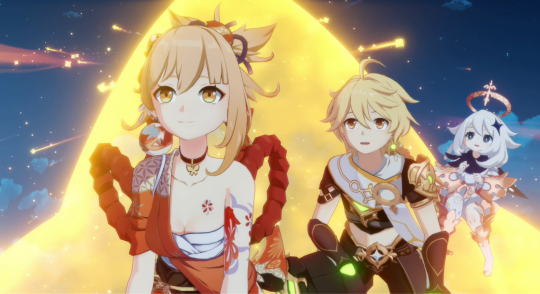
With the finale of Fontaine’s Archon Quest in just a few days, I know there’s a lot of questions I’m personally anticipating the answers to: what is the true origin of the prophecy? What is the Primordial Sea, really? What is the connection between it and the Abyssal whale? And just what exactly did Skirk mean when she said that Childe had awakened “it” and had traces of “it” on him?
Most community theories suggest that “it” just refers to the whale, but like, what is the whale? Why did Childe even see it in the Abyss all those years ago, and why has it reappeared now? Well, I have a few ideas I’d like to explore about that, albeit in a very roundabout way, and they start with a quest that I feel has been severely under-discussed and under-theorized since its release: Yoimiya’s second story quest.
It’s understandable that this quest didn’t get too much buzz between its very unfortunate timing in patch 3.7, when community burnout was exceptionally high, and Honkai Star Rail’s debut as the Shiny New Thing. But it’s also a shame, because this story quest is full of interesting lore, Freudian references, and a few intriguing world building mysteries beneath its very wholesome story and further exploration of Yoimiya’s character. That is to say, the content of Yoimiya’s second story quest really matters. It’s not just because it is the first non-Archon character’s second story quest to date — it’s because it is an incredibly important piece of the puzzle comprised of Nahida’s second story quest, Caribert, and Khvarena of Good and Evil that was preparing us for Fontaine’s plot.
This is an attempt to identify and analyze the connections between Yoimiya’s second story quest and those above, as well as to theorize about the greatest mystery in Yoimiya’s quest, the “Urstone,” and finally tie all of that into Fontaine’s Archon Quest thus far. As that is an ambitious project, this will be far from an exhaustive theory, but I hope to at least get closer to understanding the meaning behind Childe awakening ”it.”
SPOILERS: Fontaine AQ Acts I-IV, Yoimiya’s SQ Act II: Star-Pickers’ Passage, Aranyaka, Nahida’s SQ Act II: Homecoming, Khvarena of Good and Evil, Ei’s SQ Act II: Transient Dreams, Kazuha’s SQ: A Long and Friendless Road (very minor), and Caribert.
A “Story”
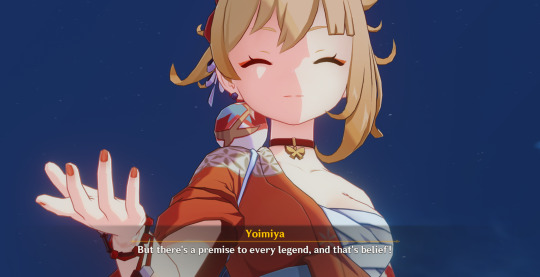
Yoimiya: But there’s a premise to every legend, and that’s belief!
Since it's been a while, let’s start with some recap of Yoimiya’s Act II: Star-Pickers’ Passage.
By chance, the Traveler comes across Yoimiya in Inazuma as she prepares to search for a great meteor shower like the one that her ancestor saw many years ago. It’s patch 3.7, so the Traveler’s got a lot of time to kill and offers to go with her from Ritou to Port Ormos. There, they come across Acara Crafts’ stall that sells Aranara carved figures, which Yoimiya buys out to bring back as souvenirs to Hanamizaka.
In Sumeru City, Yoimiya and the Traveler briefly split up to look for meteor shower leads, and the Traveler runs into Nahida at the Akademiya. Upon learning their journey’s purpose, Nahida explains that meteor showers are unpredictable occurrences related to “intricate fates” interfering with one another, and for this reason seeking one out reliably is impossible.
The Traveler and Paimon are reluctant to tell Yoimiya this out of fear of disappointing her and rendering her journey meaningless, so with Nahida’s help they decide to facilitate the meteor shower through a dream in order to fulfill her wish.
This is the first of many references to psychoanalysis and Sigmund Freud’s theory of dream interpretation in this quest. Freud thought that the psychological purpose of dreams is to fulfill wishes, particularly wishes that we’ve forgotten through repression. He believed that these unfulfilled wishes are what produce the dream itself; the wish “wants” to be remembered, and the mental processes that repress it are weakest at night, so dreams are our mind’s attempt to translate the underlying “thought” that represents the wish into “images” while we sleep. Through dreams, unfulfilled wishes can be made conscious or remembered and fulfilled through a fantasy.
To lure Yoimiya into the dream and sell her their “story”, the Traveler and Paimon craft the perfect pretext so that she fully believes that they are preparing to see a meteor shower. Their pretext’s foundation, namely the idea that meteor showers are summoned by people’s wishes, subtly twists the truth in Nahida’s words so that something intangible and uncontrollable is framed as something with an amount of certainty. In other words, by controlling the pretext, the Traveler and Paimon are able to control “truth.”
Upon reuniting with Yoimiya, the Traveler finds her with a little girl in a wheelchair named Avin. Before parting ways, Yoimiya gives her a carved Aranara souvenir to thank her for guiding her through Sumeru City, and to cheer her up. Yoimiya then tells the Traveler that Avin has an unknown chronic illness that immobilizes her legs, and that she had approached Avin because she seemed to be alone and in a bad mood.
As they refocus on finding the meteor shower, the Traveler and Paimon begin to tell Yoimiya their lie and set the plan in motion. They play the role of magicians using careful misdirection to craft a wonderful illusion; beneath the ruse of finding the right “location” (or “space”) and forging a special device (which can be anything) to observe the meteor shower, they will take Yoimiya on a journey through Sumeru and make memories with her, adding meaning to what is ultimately a trick. With these seeds planted, they head off to Devantaka Mountain to “practice” wishing for the meteor shower.
At the top of the Ruin Golem there, Yoimiya shares more about her motivations for setting out on this journey. As someone who was entrusted with the wishes of everyone in Inazuma who heard of her dream, Yoimiya began to wonder why people derive this meaning from meteor showers in the first place:
Yoimiya: People use fireworks to remember their most precious memories, and these memories sparkle and shine each time the fireworks fly.
Yoimiya: In other words, fireworks symbolize the past.
Yoimiya: And shooting stars make people think of wishes because wishes carry people's brilliant hopes and expectations for the future.
Yoimiya: One represents the past, and the other the future. They both bloom in the sky, but have completely different meanings behind them.
Yoimiya’s belief that wishes are beautiful things that join the past and the future is what gives her journey meaning, and this is what keeps her moving forward despite the lack of certainty that she will ever find this beauty herself. This admiration for the hope in people’s hearts is what shapes her wish, too.
After returning to Sumeru City, they ask Ahangar for guidance on how to forge an observation device with the purest ore. After some initial skepticism, he chooses to entertain their “story” and tells them about his own profession’s local legend: somewhere, there exists an excellent forging material that few have ever found, and the few who already have it have never used:
Yoimiya: So you mean that [the forging material] symbolizes dreams?
Ahangar: Dreams, inspiration, obsession, focus…. Call it what you want. But if you take it to symbolize “purity,” then I believe it is your goal as well.
Ahangar: We call it Urstone, but in truth, neither I nor my colleagues have ever seen it.
As they are about to set off and find this Urstone, Avin’s parents show up looking for her after she didn’t return home that day. The Traveler and Yoimiya then find Avin collapsed on the outskirts of Sumeru City. After calming her down, Avin discloses that her illness has not just immobilized her – she has also forgotten her happy memories and how it felt to be passionate before she got sick. With no end in sight to her illness, Avin’s dreams of becoming an adventurer have ended and her world feels as if it is closing in on her – as she later reflects, her world had “shrunk down to a tiny space.” Avin’s illness is an objective truth with material consequences on her life, and this truth ended the fantasy of her innocence, along with her dream of becoming an adventurer one day. This loss of innocence, and therefore loss of childhood, triggered feelings of depression and hopelessness in her. However, the Aranara carving that Yoimiya gave Avin reminded her of her childhood friend, Arashani, who she desperately wanted to see again.
To help Arashani and Avin reunite, the Traveler calls on the Aranara for help with a whistle that Nahida gave them for the dream-meteor shower. When Arapurva arrives, Yoimiya asserts herself as someone who both values childhood innocence and sees children’s dreams as worthy of protection, which earns the Aranara’s trust:
Arapurva: It seems that Red Nara has not yet grown up.
Paimon: Huh? What do you mean by that?
Arapurva: Time is very important to Nara. Nara walk with time. They remember much, and they forget much. But Red Nara is different. You know how young Nara think. The warmth in your heart is very pure, and it is fierce like the sun.
Arapurva then takes them all to Mawtiyima to find Arashani, and here they enter a collective dream. Before leaving them, Arapurva urges Avin to remember, and that to do so she needs both memories and dreams. Arapurva also says something very interesting, also worth keeping in the back of your head: “Dreams are connected to your heart, not your body.”
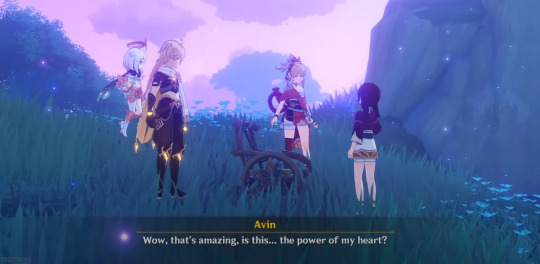
Avin: Wow, that’s amazing, is this…the power of my heart?
Video Still from Streetwise Rhapsody
The dream space allows Avin to unite thoughts with belief to create images. Remember, according to Freud, the psychological purpose of dreams is to make conscious an unfulfilled wish – so, in this liminal space between the conscious and unconscious, Avin can create the image of herself walking again just by thinking of it, because it is her wish, and thereby remember how she once felt before she got sick.
As they search for Avin’s memories of Arashani, Yoimiya and Avin chase a wayward “star” across Mawtiyima’s mushroom canopy until they reach an iridescent pale blue stone with a solid partial casing surrounding it. Inside, the stone glitters with the light of the universe.

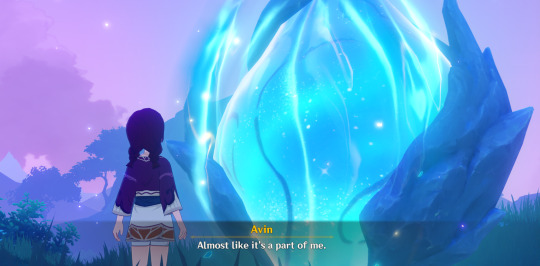
Avin: I dunno how to explain this…I don’t know what it is, but it feels very familiar…Almost like it’s a part of me.
Yoimiya speculates that this stone is what Avin has been searching for all this time, and that it is her Urstone:
Yoimiya: It's a very rare ore that symbolizes a person's aspirations and dreams.
Yoimiya: Since you can see it, that means you've found what you've lost.
Avin: Is that how it works...?
Avin: It's just like in fairy tales... I thought I'd stopped believing in those.
Avin: But I'm glad that I found that belief again.
Avin then reaches into the Urstone and passes through it into a deeper layer of the dream, and there she reunites with Arashani, signaling that she has regained her memories. Having found him again, Avin’s hope is renewed and it changes her reality – indeed, it changes her fate. To be clear, Avin can’t dream or wish away her illness in real life, but her hope is what allows her to expand the “tiny space” her world had become in her depression.
After this, the crew seemingly returns to reality, but finds that Arashani is still there along with Arapurva. Having settled her worries, Avin resolves to help Yoimiya and the Traveler achieve their wish to see the meteor shower, and offers them her Urstone…

Avin: Yoimiya, you need this Urstone because you want to see a meteor shower?
Yoimiya: Yep. Oh! Once we find it, you should come with us!
Avin: If that’s how things are…I’m happy to lend you my Urstone.
…And then, Avin pulls a light blue lens from her chest, right over her heart. With this lens crafted using the purest ore, they locate a meteor shower of stars flying up from the ground and ride them through the clouds. Finally, they wake up from the collective dream and part ways in Port Ormos.
The Purest Ore and the Will to Power

Now, there’s a lot to discuss about Yoimiya’s second story quest, and we will get to as much of it as possible, but the bulk of this theory will be focused on trying to understand the Urstone, so that is where we will begin.
Let’s start with what we know from the quest. We are told three things about the Urstone: it is “the purest ore,” it symbolizes dreams, and through the dream we are implicitly told that it represents the power of the heart.
This last area is where we’ll turn the majority of our attention, because from there we can reach a greater understanding of many worldbuilding concepts we’ve encountered in the story thus far. However, all of these definitions of the Urstone work hand-in-hand and do not contradict one another, so they are all helpful to keep in mind going forward.
But what do I mean by “power of the heart?” Well, first let’s harken back to the Aranara quest, Aranyaka, where we learned about the “Sourcesong” and the songs that split off from it through time. By learning all of the songs that represent these branches from the origin, the Aranara get closer to learning the Sourcesong:
Arasudraka: Songs are like rivers. They derive from the same origin, the "Sourcesong." She is the home to all songs and the source of all great rivers.
Arasudraka: Then, it changes when it is sung for different memories and different stories, just like how a great river diverges into creeks.
Arasudraka: Just like all the creeks eventually flow into the sea, all the songs eventually converge into one, into the Sourcesong.
Arasudraka: So Aranara song gatherers have to find all the songs. That way, we can find the Sourcesong.
These songs serve as a metaphor for another theme of Aranyaka, which is the concept of “returning to Sarva,” or returning to Irminsul after death in the form of memories/energy in the Ley Lines. It could also be extended to what we currently understand about the Primordial Sea as the origin of all life, its “source,” and all the lifeforms that arise from it are like the creeks that diverge from the river before they eventually converge back into the sea:
Paimon: What? You mean you don't believe in the prophecy?
Augereau: No, no, I believe in the prophecy, but I also believe in another story.
Augereau: The story says that people once lived in the ocean. They were one with the ocean and couldn't live apart from it.
Augereau: But as time wore on, people desired to live on land and developed blood vessels, encapsulating the sea within their bodies. Thus could people set foot on land.
Augereau: So if you ask me, when the water rises and takes us all, it'll be like we're going home.
The philosopher Friedrich Nietzsche was also interested in the idea of things differentiating themselves from a primordial source of sorts, and he uses this language in one of his many attempts to define his most well-known philosophical doctrines, the Will to Power. In Beyond Good and Evil, Nietzsche marks the inner “world of desires and impulses” as the source of emotions (Nietzsche, 35). He likens it to a primitive world where desires exist in a state of unity that then branch off into distinct organic processes. Nietzsche argues that this differentiation arises due to “will,” and that will is the “causality of all things,” and that all will is Will to Power – in other words, the will to dominate and to multiply (Nietzsche 13 & 35).
“Will” is the force that differentiates the primordial soup of our base desires and impulses into distinct organic processes, and these processes then give rise to distinct life forms that separate themselves from the original state of unity. That is, without “will,” we would all still be floating in the unified state of the primordial soup - will is both the cause, and the reason for individuality:
Mary-Ann: Water can take any shape, and life can choose what form it must take. This, however, has nothing to do with its essence. That is a different matter.
If you’ve been following the Narzissenkreuz Institute world quest plot, this discussion of “will'' should be ringing some bells. In Khvarena of Good and Evil, we came across Rene’s Investigation Notes in the Girdle of Sands, which talked about the power of Khvarena and a blurred out word (likely “Abyss'' or “Void”) containing a will of their own that can recognize itself, unlike the power of the Elements:
...Though the results are nothing impressive, this is because the object [the Khaenri’ahns] chose was pure elemental force, which lacks any will whatsoever. Like the difference between the Director and a Hydro Slime, perhaps?
[…]
Even though the calculated result is unchanged, but if the refinement method is reflected... If the power of... then maybe we can extract the "will" within. Using this method... resist the impact…
The investigation notes do two things here that we’re interested in: first, they establish the presence of “will” as the distinction between elemental energy, such as that found in Azosite, and the higher powers represented by Khvarena and “Void,” and second, they raise the possibility that “will” is something that can be removed from its vessel, so to speak, or perhaps manipulated. Just keep this in the back of your mind for now, too, we’ll come back to it much later.
If we apply this concept of will back to the Sourcesong story, then it is will that differentiates each song into its own unique form, but each song still contains the essence of the Sourcesong from which it arose. A similar story is told about the five branches of the Raiden Gokaden. In Kazuha’s Story Quest, Amenoma Tougo likens the Raiden Gokaden to schools of thought that originate from a single source, with each branch carrying its own philosophy. Kazuha’s family’s school, the Isshin Art, seeks “complete harmony between blade and mind” during the forging process, because they believed this was the only way for a blade to “capture and convey its maker's thoughts and feelings, and eventually become an extension of its wielder's will.”
This is a very important concept as we move forward. If we think of will as what differentiates each forging art of the Raiden Gokaden from each other and their source, and each branch is considered a unique school of thought and philosophy of blade forging, then thoughts are an essential component of will. If a blade that these philosophies produce is meant to capture the thoughts and feelings of its respective forging branch, such that they are an extension of will, then will can be further defined as the cause and reason that an abstract form (thoughts and feelings) is translated into a physical form (an object, such as a blade). It is both the how and the why.
Put another way, the blade is the bladesmith’s will embodied. It is the bladesmith’s thoughts and feelings, which we have just established are an essential component of will, given a physical form. The thoughts and feelings are will, the object is will, and the “force” that translates the abstract into the physical is will. So basically, it’s all will, but in different forms.
But so what? Well, let’s go back to the amazing feat that Avin accomplished towards the end of the story quest. She asks Yoimiya what she needs, then says she will lend her Urstone to Yoimiya to help her achieve her dreams, and what does she then do? She pulls a viewing lens from her chest, right over her heart.
That is what the Urstone is. The Urstone is the source of a person’s will, and the Urstone is associated with the power of the heart, which would also make “will” the power of the heart. Will is what underlies the power of creation and imagination, or as Ashikai puts it in her theory of Irminsul’s true purpose, the power by which “thoughts become things.”
The purest ore was needed to craft the observation device, and of course the purest ore would come from the purest will – a child’s will. What’s more, Yoimiya and the Traveler never even mentioned what kind of device they needed to forge with the Urstone. It was Avin’s will to help her friends that materialized their thoughts into an object. The implications of this are fascinating, though this theory isn’t going to go there. Instead, I’d recommend watching Ashikai’s video above if you’re interested in that train of thought.
The Seed of Ideas*
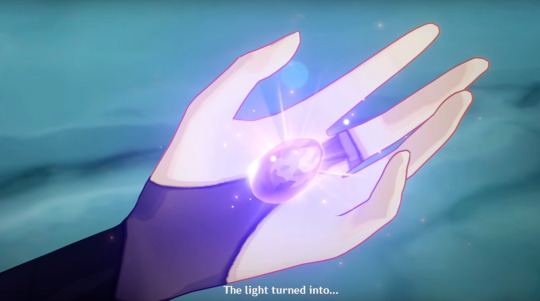
Paimon: The light turned into…a seed?
Having established this connection between thoughts/feelings, the power of the heart, and “will,” let’s see how else we can think about the Urstone. I noticed that “will” turns up in a couple of other recent to semi-recent contexts, and both of them involve the origin of some important trees in the open world.
To start, let’s revisit Ei’s second story quest. As a lightning fast refresher, Ei and the Traveler were investigating Rifthound activity near the roots of the Sacred Sakura tree, which we know protects Inazuma by purifying “filth” from the earth, or rather the memories of people who died on the land. This is meant to mirror Irminsul, since the Ley Lines also contain memories and are Irminsul’s root system. With the Sacred Sakura’s roots damaged, this “filth” leaks out, and the memories within are briefly re-projected onto the land.
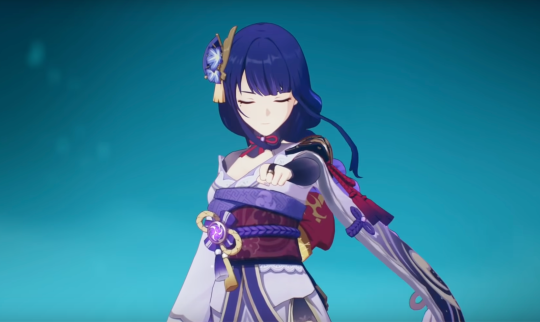
As Ei confronts her past through these memories of Inazuma, she vocalizes her change of heart since the Vision Hunt Decree and her newfound will. The Shogun then challenges her to a duel in Raiden Makoto’s realm of consciousness, which Ei preserved before she passed away 500 years ago. When Ei successfully proves the strength of her will to the Shogun, she awakens another fragment of Makoto that she hid inside Musou Isshin. Interestingly, Makoto calls this a fragment of her will. Upon awakening her will, it becomes a seed that Ei plants in the realm of consciousness, which grows the Sacred Sakura tree in the real world. In other words, the Sacred Sakura tree is Makoto’s will given a physical form, another example of someone’s will embodied.
But this is not even the first time that will has been represented to players as a seed. In Dragonspine, the Frostbearing Tree goes through a physical transformation as the Traveler offers it more and more Crimson Agate, which is a crystal tainted with Durin’s abyssal blood. After offering enough Crimson Agate, we get the blueprint for the Frostbearer catalyst, which tells us an interesting story:
A long, long time later, yet still long ago —
When the deathmatch between the dragons of darkness and wind was decided at last,
When corrosive blood stained the ashen valley red,
The tree, at last, remembered that it had not died with that entombed city,
And it extended its greedy roots towards the warm ichor that irrigated the land.
Because a certain someone poured out a crimson essence upon it,
The tree that should have long died remembered its past,
And bore a single fruit from the coalescence of all its might…
As creepy as the Frostbearer catalyst lore is, there’s another useful analogy to be made here so that we can better understand Avin and her Urstone.
Think of Avin as the Frostbearing Tree, a tree that “should have died” but remembered its past upon being offered Durin’s blood. This may seem like a strange comparison at first, but Durin’s blood is conceptually not so different from the memories flowing in the Ley Lines like water, or the filth flowing through the roots of the Sacred Sakura tree, just as Durin’s “heart” is likely a similar anchor for his consciousness as Elynas’s is, just as Makoto’s fragment of her will became the seed or “source” of the Sacred Sakura, or the “Urstone,” we theorize, is the source of an individual’s will.
Basically, Durin’s blood is a liquid form of his will that can change the “shape'' of the objects it comes into contact with, and upon being exposed to it the Frostbearing Tree remembers what its life was like before the Skyfrost Nail dropped on Sal Vindagnyr. This is very similar to how Avin remembered her happiness before her illness through the magic of the dream space and finding her Urstone. And upon remembering its past, the Frostbearing Tree bears the “fruit” that is the Frostbearer catalyst, the “coalescence of all its might,” but Avin bore the observation lens. Both are products of their source’s will, but have different emotions behind them due to their difference in purity.
But there’s one last thing I want to point out about the Frostbearer catalyst before moving on to the next point. A fruit is like a sugary case for a plant’s seeds, so what might this structure be in the center of the Frostbearer catalyst?
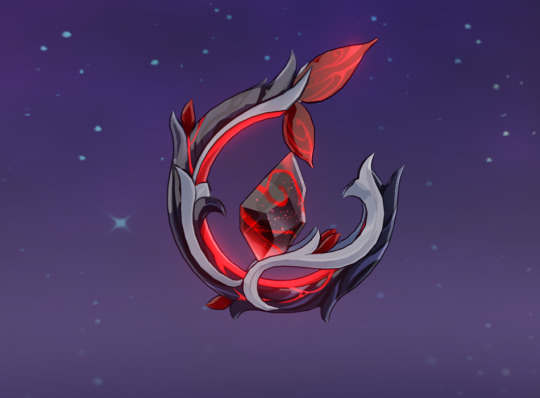
That’s right. A “seed,” which also resembles a gem or a stone. And not too unlike the general shape of the Urstone, I would add.
But you know what else the Frostbearer catalyst and the Urstone really remind me of? The Fire Seed from Nahida’s second story quest. Although the Fire Seed neither becomes a tree nor seems to come from one (though this is also debatable if you consider Rukkhadevata and Nahida to be like…smaller trees, originating from Irminsul), it’s still worth talking about if only for a potential analogy between it and the Urstone.
The Fire Seed has obvious visual similarities with the Frostbearer catalyst, with both “stones” or seeds in the center of them having the same overall shape - the Traveler and Nahida even call the Fire Seed a crystal before they learn what it is from the elemental life form in the Chasm.
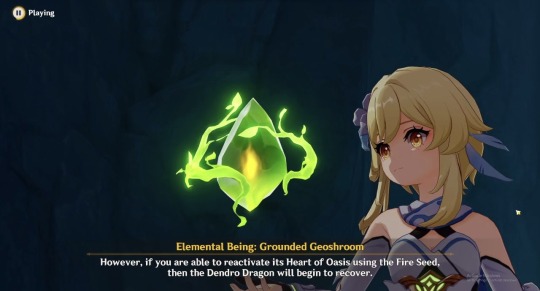
Video still from Star Dragon X
The Urstone also generally looks similar to the Fire Seed in terms of the stone’s shape and the orientation of the casing-like objects around it, but there’s a more compelling analogy to be drawn between their composition. The Fire Seed is described as an extremely high concentration of elemental energy in a very fragile or unstable state, and we know from our understanding of Irminsul that elemental energy is another form that memories can take. While it’s not clear if passing through the Urstone is the same thing as entering the Urstone itself, Avin does access more of her repressed memories of Arashani after doing so, allowing her to “remember,” as Arapurva asked her to. So, both seem to contain memories.
You may also know that the prefix Ur- in Urstone means primordial or original, something from before the present. This leads me to wonder if that light of the universe glowing from within the Urstone is what Roozevelt calls “primal energy.” Hoyoverse does like to worldbuild through analogies and allegories, so I wouldn’t be surprised if the visual similarities between the Fire Seed and Urstone were meant to be a tip for a functional similarity as well.
Finally, there’s the relationship between the Fire Seed and Apep’s Heart of Oasis. The Fire Seed was made by Greater Lord Rukkhadevata with the help of Apep’s “children,” the elemental beings that split off from that “source.” It is meant to mimic the Heart of Oasis and the way that it functions, which tells me that all of this will/”heart”/source as a seed imagery is being repeated for a reason, because it’s meant to teach us more about how “will” works.
Remember how the Aranara believe they can find the Sourcesong by learning every song, and how this points to the idea that the essence of the source is retained in each of its “children,” despite the unique form that each song takes? Well, let’s think about that for a second. For example, think about how light shining through a prism will split off into unique colors - each color is distinct from the other, with a unique character and “form,” so to speak, but each color still originates from light. Red, green, and blue may all look different from each other, but each tells you about a characteristic of this thing called light.
I think the same is true about these “seeds.” These fragments of an original consciousness can take the form of seeds because that is one facet of the essence of the source. That’s why an Urstone can be so many things at once: a “heart” (though not corporeal), an “ore,” a source, a will, and a seed. That is because each fragment of the source’s will conveys a small “idea” taken from the original consciousness, and these ideas are like fruits born from a tree. If you were to “plant” these seeds in the ground, the ideas would spread across the land, thereby allowing one’s will not just to dominate, but also to multiply.
*The “Seed of Ideas” heading title is taken from an enemy in Honkai Impact 3rd introduced in Chapter 33. Lore-wise, they’re actually not a great example of the idea I’m trying to illustrate here lol. So don’t think too hard about the heading if you’re a Honkai 3rd player – I just thought it sounded cool. >_>
Wherefore Did the Spirit Tree Grow?

“But the reason it is effective is due to the nature of the origin, the primordial... based on the records, the constituent elements should be a "Circle of Four Orthants" and a "Tree of Emanation"... flows from the roots toward the center of the circle, and the circle encircles the abstract of... It's akin to pie crust and the filling of the pie, a metaphor sure to excite Jakob.” -Book of Revealing, Enigmatic Page VIII
And plant them we shall! That is just what Greater Lord Rukkhadevata and Raiden Ei did with Egeria and Raiden Makoto’s consciousness. Egeria’s consciousness sleeping in the Gaokerena has always reminded me of Avin’s Urstone, long before having the language of “will” to talk about it, but I could never quite explain why. I think the answer is a little more clear to me now, though there’s no concrete way to prove this theory at the moment. The Harvisptokhm, the Sacred Sakura, and I would also venture to guess the tree at Windrise are the result of planting either the source of consciousness or a fragment of consciousness, which anchors the consciousness to the mortal realm and allows it to exert its will on the land by purifying and containing its “filth.”
These trees all belong to the consciousness of gods and ascended allogenes, but Avin is as ordinary as they come, so how is it possible to suggest that her Urstone is anything like the Gaokerena or Makoto’s will? Maybe all that’s missing is “time”?
So…what is "it"?
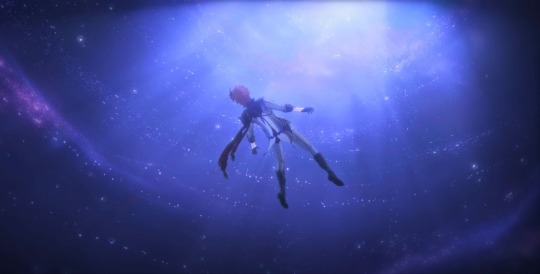
“An external form is but a gift of time. Through ‘growth’ comes change, and even abandonment of previous forms. However, our true nature is not so easily affected.” –”Where Lies the Path Home,” Sapientia Oromasdis: Act II
Now with all of that set-up out of the way, let’s get to the heart of the matter here…ignore the pun.
The Archon Quest establishes early on that Childe’s Vision’s malfunctioning and his bad mood are connected to one another, and with Act III and IV we see that Childe is literally being summoned by the whale – it is calling out to him, drawing him into a rift where it swims in the Primordial Sea. His Vision’s malfunctioning is what I want to zero in on first to begin to answer the larger question of what the whale is and explain Childe’s movements so far.
Once again, Aranyaka becomes very relevant here. When the Traveler saves Rana at the end of the quest after resealing Marana’s Avatar, Rana resolves to go out on an adventure and receives a Vision of her own. Though we are not shown a visual of this, it is described on a black screen of white text:
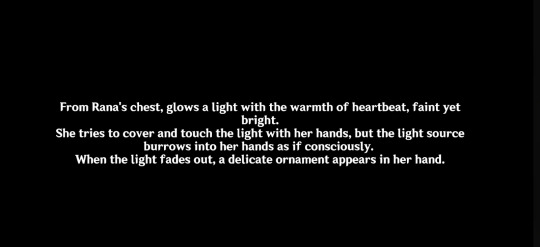
Rana pulling the Vision from “a light with the warmth of a heartbeat” from her chest is imagery we’ve already seen before, when Avin pulled the lens from her chest in the collective dream. I mean, isn’t the parallel a little too on the nose here? Avin created a lens, something you use to see and perceive, and Rana was granted her…Vision? …Why are you booing?
Although Rana’s is the only Vision story so far that fits this imagery like a glove, I think Act III and Act IV offer some more support for where I’m going with this. Despite having Childe’s Vision in their possession since Act I, the Vision is shown twirling at the beginning of every dream sequence the Traveler experiences in the Fortress of Meropide, sequences that seem to be copies of Childe’s memories while he was a prisoner. The fact that the Vision doesn’t need to be on the physical person of its wielder in order to transmit these memories could be an indication of a deeper connection between the Vision and the wielder – that is, the Vision is similarly a physical extension of its wielder’s “Will,” created by their Urstone or “Heart,” and therefore is a part of them, like the fruit of a tree. And if that’s true, then Venti wasn’t kidding when he compared Visions to organs.
This also puts the Vision’s malfunctioning into a different perspective. To go back to Nietzsche’s statement about Will to Power, will can only operate on will, and will is the causality of all things – through this lens, it may be correct to say that the traces of “it” that Skirk could sense on Childe are traces of the Abyssal whale’s will, and that its will is interfering with Childe’s own will at this fateful moment.
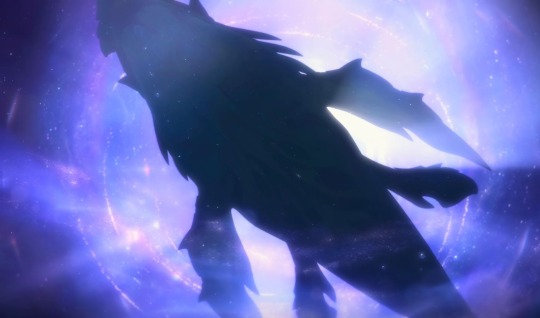
If we buy the idea that will is at least part of what can change your fate, and that Childe has traces of the whale’s will left on him, then the secret of why “it” has reappeared now may have been foreshadowed by what Nahida said in Yoimiya’s second story quest: that “meteor showers'' appear as a result of many intricate fates interfering with one another.
Specifically, it’s an allegory for Childe and the whale. The dream Childe had when he fell into the Abyss and the meteor shower are analogous, to be sure, but let’s not forget about our good friend Mr. Freud here either, who’s analysis shows us that dreams are suppressed wishes translated into images. From that perspective, it would also be correct to say that the meteor shower is analogous to a wish. That is, Childe’s fate and the whale’s fate are interfering with one another because of their encounter in the Abyss when he was a young teenager, and perhaps the Abyss appeared that day because Childe’s fate and the whale’s fate were interfering with each other then too - and that this was Childe’s wish all along:
“Pursued by bears and wolf packs, he lost his footing and fell into a bottomless crack in the earth's surface.
There, he witnessed the endless possibilities of another ancient world. There, he would meet a mysterious swordswoman...
Or perhaps one should say that this dark realm had sensed the burning ambition in this boy's heart.” –Tartaglia, Character Story 4
As for the larger question of what the whale is, it’s likely not very different from Visions, or the blades of the Raiden Gokaden, or Avin and the lens. It is an extension of the Abyss’s will that branched off from its source a long time ago, a primordial being much lower on the Abyssal phylogenetic tree than the more humanoid Abyss Heralds or mages. That’s as far as I feel comfortable speculating about its origins for now, but I hope we get some clarity on its age and “distance” from its source very soon. Speaking of which…we haven’t talked about Caribert yet, have we?

There’s something eerily similar about the way that Avin described her world as a “tiny space” before changing her fate when we consider the additional context of Caribert. When he regained consciousness, he said it felt like he had just woken up from a “long dream,” and that in his dream he was hiding in a “little room,” and that he had no desire to leave it. I think this language is similar on purpose, and it tells us some more crucial information about Urstones, will, and their relationship to these curses placed on the Khaenri’ahns.
The “little room” and the “tiny space” are metaphors for a person’s perspective, which has been repeated over and over again in nearly every Fontaine world quest thus far to further our understanding of aesthetics. It’s clear from those quests that an individual’s perspective is limited, but it can be broadened by interacting with others + the passage of time, and that over long periods of time these perspectives allow for aesthetic values to change. Thus, the world is also changed. But the opposite of change is stagnation, and stagnation is precisely the result of losing the ability to connect with others - indeed, the will to leave the tiny room.
We’ve already established that when “will” exerts its influence on another will, it can change the “shape” of the will it is dominating - the Frostbearing Tree is a great example of this. The Hilichurls have also had their external forms altered, and they erode away until eventually dissolving into the mud in the Chasm. So maybe, just maybe, the “curse of the wilderness” is a result of their will being tampered with by the same “thing,” such that their inner world becomes so small that they cannot find their will anymore, and therefore they cannot change their fate.
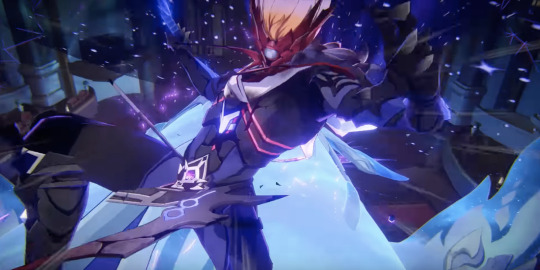
Childe is briefly seen fighting the whale in his Foul Legacy form in the version 4.2 trailer
Now, I’m not suggesting that the traces of the whale’s will would ever result in Childe becoming a Hilichurl, or that the whale is responsible for the curse of the wilderness at all. What I am wondering is if this is why Skirk took Childe up as her disciple – to teach him a “form” of combat that would maintain his grip on his will, on some kind of “belief,” not allowing it to be dominated by the whale’s will, so that there is yet hope that Childe can change his fate.
And if that is true, then here is my last theory before I disappear: Yoimiya’s belief that a child’s wish is precious and worth protecting is likely an allegory for Skirk’s motivation to train Ajax, and the relationship between Yoimiya and Avin is also meant to foreshadow them – a master and her disciple, a traveler from afar and a child of this world, a child-at-heart and a child who is lost. This core belief is what makes Yoimiya’s heart pure, and by passing that belief on to Avin, she plants the seeds of new hope for her to defy fate, and one day she may do the same for someone else. This, in essence, is the meaning of will, and that is what I believe Skirk’s lessons were meant to teach Ajax. And that is a twist that I truly never saw coming.
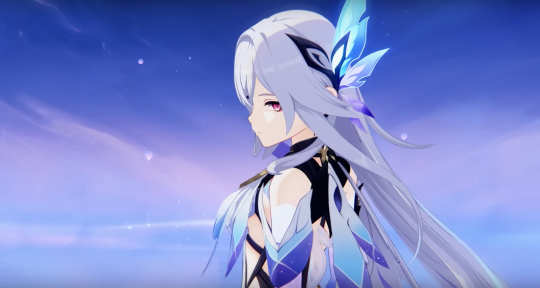
TL;DR: The Urstone is the source of will that exists in each person, will is what translates thoughts into images and objects, smaller "wills" or "ideas" split off from the Urstone/heart/source/consciousness and allow for will to spread and exert its influence on other wills, and Skirk may have more in common with Yoimiya than you thought.
Thank you so much for reading, I really hope it made some sense. I would love to hear what you think of all the lore up to this point and what you make of it! :)
Sources
Yoimiya Story Quest Act 2 (Full Quest) Carassius Auratus Chpater: Act II | Genshin Impact - YouTube- grabbed the “is this…the power of my heart?” screenshot from here because I forgot to take it in my alt’s playthrough.
Nahida Story Quest 2 - Using the fire seed to save Grounded Geoshroom | Genshin Impact 3.6 - YouTube - Video still of Lumine holding the fire seed from this video.
Beyond Good and Evil by Friedrich Nietzsche, which you can read for free here. Page numbers are given from my hard copy.
A General Introduction to Psychoanalysis by Sigmund Freud, also can be read for free here.
For more analysis of the Will to Power doctrine, check out Stanford Encyclopedia of Philosophy.
#genshin impact#genshin lore#genshin theory#genshin meta#genshin impact lore#genshin impact theory#fontaine#tartaglia#childe genshin#skirk#yoimiya#theory
73 notes
·
View notes
Text

If I had a nickel for every time we got vague hints about the Traveler being an inhuman, eldritch monstrosity from the abyss, I'd have three nickels.
Which isn't much but it's weird how it's happened thrice in Fontaine now.
Hoyo please, just tell me what they are...
112 notes
·
View notes
Text
Share this before they ban me.
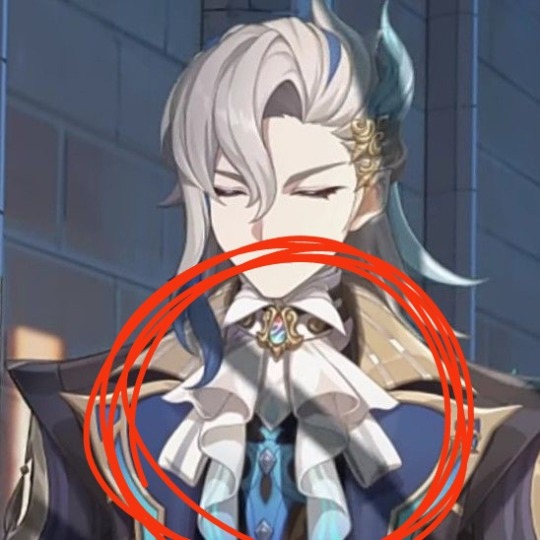

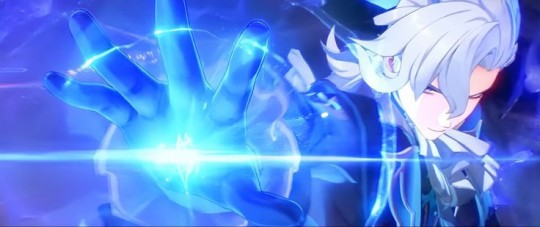

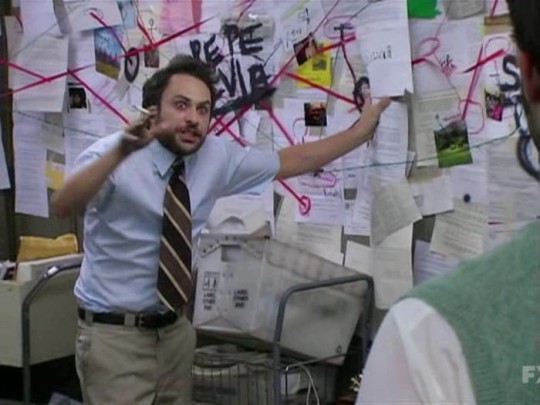
#genshin impact shitpost#genshin impact theory#genshin impact#genshin impact neuvillette#genshin neuvillette#neuvilette genshin#neuvilette#neuvilette fontaine#genshin fontaine#fontaine#winx valtor#valtor#winx club
83 notes
·
View notes
Text
About The Kaveh Reincarnation Theory
I will make this theory make sense and no one can stop me.
Story Parallels
We know very little about the Goddess of Flowers but her connection to Kaveh is less about backstory and more his personality.
What do we know about her? She foresaw her own death in the cataclysm and didn’t run away from it. She facilitated her so she would leave a legacy greater than herself behind. And she did, creating the Jinn and the Khvarena. And what does Kaveh do on a near daily basis? Break himself over and over again to create things that will outlast him. And while he has succeeded in creating great things, he is still trying to make a legacy, no matter how much he brings himself to a closer ending than he should ever have.
Artifacts
Honeyed Final Feast
"In those days, the moonlight would tell of their happiness to the nightingale and the rose."
"And they were so frightened and abashed that they could sing no song in response."
"Peace and ease reigned, and there was no division or misfortune in this worriless paradise..."
"If only these wonderful days, as lovely as a shimmering mirage, could last for eternity, and that they should never have to taste the bitterness of parting."
Could possibly parallel Kaveh and Al Haitham’s relationship before their falling out, as well as how Kaveh was living at what he thought to be the high point of his life before he ended up homeless.
Later, time sundered the contract between day and night, destroying the ancient oath.
The gentle moonlight sank into the quicksand. The sun shrouded all things in its fearsome gaze.
The mention of quicksand is interesting, considering that is how Kaveh’s father died.
Dreaming Steelbloom
"When the moon leaves your palm, and the lonesome silver light retracts from atop the labyrinth on the sand ocean,"
"One hopes that you will remember how your companion in the dreams shone like the burning sun."
This is the same line I pulled for the Al Haitham write up but it still tracks as a possible parallel to Kaveh and Al Haitham’s falling out. Or rather, an implication that if things were to continue as they are, history might repeat itself between the “sun” and the “moon”
Ay-Khanoum's Myriad
In a bygone time which only the Jinn recall, the Lord of Flowers was cast aside by the heavens.
Her magnificent vessel was left a savaged husk, her kinsfolk punished by way of being stripped of their minds...
Legend has it that the Lord of Flowers wandered the barren wastes for seventy-two nights...
Her heels were worn through by the merciless gravel. Her wounds gushed into limpid springs, turning into streams with no boundaries.
Could act as a parallel to Kaveh losing everything he has to create the palace and being homeless afterwards.
Wilting Feast
The Lord of Flowers capitulated to her friend's folly, finding a most admirable rebellion burning within the ambitions of the god.
An idea that joined the wisdom of thousands, and the great attempt at binding their dreams to power.
What hides here is more than lies, but also the future of humanity, burning like the sparks of hope...
Dreams will always dissolve, their landscapes fated to collapse — this is the true meaning of the blooming flowers.
Only by suffering through the destruction of a god's delusions can humanity learn to rise against divine will...
Just as the stubborn God King orchestrated this secret rebellion, surviving on the strength of individual will alone.
However, the Lord of Flowers never knew a love that could be as sweet as wine, let alone the paltriness of human emotion.
Brilliant as she was, even she could not easily predict when these little beings would finally realize the truth...
"... Have these so-called gods not been superfluous to you since the beginning?"
Oh boy, there’s a lot to unpack here, but I’ll attempt to simplify.
This is the very culmination of the parallels between Deshret and Nabu Maikata as well as Al Haitham and Kaveh. The main purpose here is that the Goddess of Flowers never truly agreed with Deshret. She could never fully believe in his ideas, yet she stayed by his side anyway in a hope that they could do something truly selfless for their people. This is almost one to one Al Haitham and Kaveh’s dynamic. They will never see eye to eye. Yet they are each other’s mirror, equals in every way.
And like the past, eventually these ideals clashed and the dream died. Deshret, like Al Haitham, chose to do all his work on his own. And Nabu, like Kaveh, did everything she could to be selfless, but could really only watch as her world crumbled. Nabu and Deshret’s love, like Kaveh and Al Haitham's, wasn't sweet. It was chaotic, all over the place, impossible to fully pin down and yet it was still there. After every tragedy, after every hardship, after the times where they believed they were nothing to each other, the emotions there had never grown dull.
The final thing to connect is the question Nabu was asked and the question Al Haitham asked Kaveh.
“How has realizing your ideals gone for you?”
For Nabu, the answer was to design a legacy born of both bitterness at life and the gods, as well as so those after her could live on. For Kaveh, he hasn’t figured out his answer yet.
Secret-Keeper's Magic Bottle
In a bygone time on which the Jinn alone are silent, King Deshret poured his deepest ambitions out before the Lord of Flowers...
As the moonlight's visage drifted across ripples within a glass of pomegranate wine, the Lord of Flowers finally succumbed to the persuasion of a friend most beloved.
The words King Deshret spoke that night remain unknown to all. Even the eldest Jinn bestow only silence when asked about that which was said.
None know what secret desires King Deshret revealed in the dark past daylight, desires that might shock even the wisest of gods.
But the Lord of Flowers herself drew enlightenment from the exchange. It had been within her calculus — something long foreseen.
.
.
.
"Know this: if there is to be hope in this world, it will be found kindling within mortals most ordinary."
Acts as a parallel to Kaveh and Al Haitham’s project while they were still in school. Also parallels Al Haitham’s closed off self reliance and Kaveh’s desire to give pieces of himself to others.
Connections to Real Life
The only name given to the Goddess of Flowers is Nabu Malikata. And while the first half of her name can’t really be attributed to Kaveh (Nabu being an ancient Mesopotamian god of literacy, the rational arts, scribes, and wisdom), the second half of her name can. Malikata can be translated to the ideogram of the Middle Persian word for queen, MLKTA. More proof of this is found in the Eternal Oasis, in her name is written as “NABU MLKTA” in the in-game Deshret Script, the same as the ideogram of the Middle Persian word.
Kaveh’s name, as I’ve learned (shout out to my friend Cado, who unintentionally helped me with a lot of this) is a very common Iranian/Persian name for boys. That’s just a fun fact, more specifically, the name came from the Shahnameh, or the Book of Kings. The name Kaveh was used for a character in the tale of Zahak the Serpent King, in which the Zoroastrian gods played major roles.
The Goddess of Flowers, created something known as Khvarena, which in Genshin is a purifying spirit, but in Zoroastrianism, is a concept of a divine power projected upon and aiding the appointed. While it could be considered grasping at straws, reincarnation or being the vessel of divine power could be considered a form of Khvarena in real life Zoroastrianism.
Now, we have no Goetic name or twisting of a Goetic name for Nabu Malikata, we can also lift from Egyptian mythology considering Deshret’s true name is Amun. The consort of Amun/Amun-Ra is Mut, sky, fertility and matriarch goddess said to be born from the primordial waters of Nu. This could be the proof of Nabu Malikata’s true name as she has been shown to have connections with Egeria, who wielded the power of the Primordial Sea. And, while not directly from Fontaine does have connections to it as his mother moved there.
As for Mut as a name, it could be twisted in Mathim, an alternate reading of Bathin, a demon said to know the virtues of precious stones and herbs.
Conclusion
Oddly enough I feel like this theory is far more concrete than the one with Al Haitham. With references to Persian mythology, mytho-history, and history in both the Goddess of Flowers and Kaveh, as well as the parallels in their stories, the theory actually feels very water-tight. Perhaps my theory with the most proof to date.
#genshin#genshin impact#genshin impact theory#genshin theory#kaveh#genshin kaveh#goddess of flowers#nabu malikata#should I tag the ship?#i'm tagging the the ship#al haitham#alhaitham#haikaveh#kavetham#it's not really about the ship but i do mention it#so this is just to be safe
76 notes
·
View notes
Text
CBT Venti's lines to Dvalin towards the end of the Mondstadt Archon Quest, pulled from here:
"Even without my order, you still saved us. Your true nature couldn't be twisted. I never summoned you, because I never wanted to order you again. One hundred years ago, you fought that evil dragon, and it brought you so much pain. I want you to be free-- free to make the choices you want to. You are so beautiful, you should be free to do as you please."
I'm? Going to cry? There's something about the way Venti speaks here that's admittedly far more better than the released version. Him calling Dvalin beautiful? Constantly reinforcing the fact he does not want to order him to do anything? I don't know. I just love this more and wish Hoyo would have kept, at the very least, "You are so beautiful, you should be free to do as you please."
We know that when Venti says here: "One hundred years ago, you fought that evil dragon, and it brought you so much pain" is incorrect because of the 100 years. If I'm not mistaken, the battle of Barbatos and Dvalin vs. Durin would take place 500 years ago during the start of the Cataclysm, but this could have easily been changed in the final version.
It also seems that in CBT, that without Venti using whichever power he did to help Dvalin, there would have been more consequences after the Abyss Order's manipulation.
"It's too late, although I have returned, I will soon..."
Then, when Venti uses the power, Dvalin says:
"What are you doing? You will die too if you don't stop..."
To which Venti replies, "I can let go of my mortal presence."
I'm a bit confused by this, to be honest. The cutsene plays out the same in the finalized version, and we see Venti on top of the Anemo Archon statue indicating nothing tragic has happened. I can only think of these particular lines being a "stretch" so it was changed in the finalized version. I think of it as Venti expanding a large amount of his power to fully purge Dvalin of the corruption, thus making him pass out after he uses his power.
Dvalin isn't beating the Anemo Dragon allegations, but I'm still a bit on the fence with that theory (and it is still a theory as nothing has been proven).
The main point of all of this is that regardless of whether or not it's the CBT or the released version, from day one, the game shows Venti's selflessness and his desire for Dvalin and Mondstadt to be free only for all of that to be ignored by fandom. Anyway, I just fucking love Venti.
#genshin impact#genshin impact theory#venti#krisposting#txt#which leads me into my next point for a much later post:#any depiction of venti being evil just to be evil instead of at LEAST morally grey is grossly occ#*ooc
87 notes
·
View notes
Text
Starting to believe that the only reasons all the Archons aren't in full-on rebellion against Celestia is that either a) they don't agree with the methods of the Tsaritsa and Abyss Order, or b) they're genuinely terrified of Celestia's reprisal.
As early as the Genshin Impact prequel webcomic, Venti implies he doesn't feel comfortable in Celestia and prefers avoiding them. Zhongli was rather peaceful about giving away his Gnosis to the Tsaritsa, his only (known) condition being that he ensure his people can carry on fine with no Archon. Ei began the Vision Hunt Decree and closed off the nation precisely because she was terrified of what Celestia would do if her people got too ambitious. Nahida was completely willing to destroy her Gnosis, and only refused because the allure of secret knowledge won out(which she was very happy to share with us.) And, as we've just seen, Focalors spent 500 years on a plan to destroy her Gnosis and consciousness, to give Neuvillette back his full power and subvert the prophecy, as well as mentioning how she'd be hyped to judge Celestia for their crimes and just didn't get the chance.
By this point, the only thing I'm surprised by is that War God Murata hasn't just thrown in her lot with the Tsaritsa and joined the rebellion. I mean. War God!
Anyways, unfortunately the Archons' fear of Celestia's reprisal is...entirely reasonable. We've see what happened to Sal Vindagnyr and the Chasm. We know what happened to Khaenri'ah. And Orobashi sacrificed himself because Celestia was ready to annihilate his country, because he accidentally saw a secret in a book.
Thinking on all this a little further, I begin to wonder again why the Tsaritsa wants all the Gnoses. If she's using them to create a weapon or power herself up, then Focalors destroying her Gnosis is bad for her plan, but not that bad. She may be able to bypass this by just asking Neuvillette to lend some power in assistance, and after Tartaglia and Arlecchino helped immensely with the prophecy(and since he's made it clear he really hates Celestia anyways), he may not have any actual reason to refuse. But if she was always planning to destroy them, or if she just wanted them so Celestia can't mind-control the Archons through them or something similar, then this doesn't actually affect her plans at all, or even speeds them along.
#genshin impact theory#genshin theory#genshin impact analysis#archon quest#genshin impact 4.2#genshin impact 4.2 spoilers#fontaine spoilers#archon#neuvillette#the tsaritsa#i finished like 90% of the archon quest just gotta do the epilogue#so maybe arlecchino says something about the tsaritsa's plans in there idk
126 notes
·
View notes
Text
Call me dumb, call me naive, but there's nothing you can say that will convince me otherwise.
We all know that infamous cutscene of the traveler running with what looks like a destroyed Khaenri'ah, red skies and ruined land with The Heavenly Principals insidious cubes raking havoc across the land.
Everyone says that it looks similar to Mondstadt. And they theorize that Mondstadt was built above the ruins of Khaenri'ah. I even heard that Mondstadt was Khaenri'ah because of how similar their architectural styles and placement were.
This has never, and will never, make sense to me. Firstly, it's been shown and confirmed that Khaenri'ah was under Sumeru. We've seen the doorway to it. Secondly, Khaenri'ah was destroyed 500 years ago. Destroyed by the 7 archons and Celestia, after the archon war. Therefore, Mondstadt was already placed and established during the reign of Khaen. How can Mondstadt be built on top of Khaenri'ah if it already existed?
"Maybe they moved locations-" I cite my sources to the 2020 genshin impact comic on Webtoon where it clearly shows Mondstadt in its current day location. It follows the story of Vanessa and dips a little bit into her lore. Vanessa ascended to Celestia a 1,000 years ago. So current day Mondstadt still resides in its place even after the events of Khaenri'ah 500 years ago.
I don't think that cutscene was Khaenri'ah even though so many people claim it is. It's too similar to Mondstadt. No, I firmly believe, I mean heavily believe, I MEAN I will develop a religion based on this belief; That was foreshadowing the destruction of Mondstadt.
Celestia is going to destroy Mondstadt. We all know Venti- Barbatos- Is really important to genshin lore. He even says he's "being watched" by someone that we can only assume is Celestia.
He's the god of freedom, holding the Queen chess piece, shown to be one of the strongest, if not then THE strongest, archon. Rather that's with physical power or will power. He's a mysterious and secretive person who says just enough to get by without suspicion. He has skeletons in his closet and we've seen that hinted with the upside down statue, a blatant disrespect to his name.
Mondstadt has "The Gateway to Celestia" etched across the Barbatos statue, which is a mystery all by itself. All the other nations have has a Chapter and different Acts. We have yet to have that with Mondstadt. We only have seen a Prologue for that nation.
There's more to its story, and I believe the next time we go back to Mondstadt it's going to be a full circle. We started in Mond, now we're going to end in Mond. That end is going to be that cut scene with the red skies and ruined land.
#sweethoneyfruit talks#genshin impact spoilers#genshin impact venti#genshin impact theory#genshin impact#genshin impact lore#genshin impact x reader#venti x reader#genshin venti#mondstadt#genshin men x reader#genshin men
104 notes
·
View notes
Text
My theory about Furina is that the girl we know is simply a meka/puppet expertly made to look like the real Furina (we know this is possible with Ei, she has two puppets in her likeness), and the reason Neuvillette HAS to be around her at all times is because she isn't allowed to talk about highly secret topics, unlike the real Furina, down under the opera house, under the Oratrice, powering her Gnosis with the people's belief (in Justice, of which she is the archon). I believe she must be holed up there, possibly buried in research, likely trying to solve the primordial sea crisis without alerting the research institute, and I believe that she was the one who called out to Lyney when he performed his trick.
Neuvillette, as the dragon bound to the hydro archon (I HATE when they throw away these tiny lines that reveal insane lore, like how Celestia stole the dragons' power to give to the archons, which I now believe to be what is stored within the Gnoses. This also informs my idea on what the Tsaritsa is planning, but that's another theory haha) is faithfully taking care of this Meka-Furina and covering for her weaknesses. When she doesn't have clearance to speak on a matter, Neuvillete steps in. When a matter has no bearing on her true, secret work, she is free to act as she wishes (though she does still have a sort-of retainer in Chlorinde, who seems to know plenty more than she lets on). He attends important meetings at her side and rules over the court, responding to the oratrice, in order to keep up appearances while the true archon is trying to solve the crisis. And perhaps, the supposed real Furina is the one calling the oratrice's judgements, instead of it being The People; and when she noticed something off about Childe, she overruled the guiltless charge.
I can't explain the "curse" thing, perhaps it's just tied to the oratrice or the primordial sea, I have yet to know enough about her to figure out the curse's nature, but I think my theory covers a lot of ground otherwise. A meka created only to be a figurehead doesn't need to have any power within it, and as we've seen with Raiden, puppets are capable of having their own personality. In the past I considered Raiden's personality to be the "robot is emotionally cold" trope, but now I think Raiden was created to be strict and unbending on purpose by a grieving woman, as such traits would make her a perfect ruler in the absence of the real one - which also makes her reaction to Wanderer's gentleness make more sense. Rather than "omg why is he crying?? Sweet boy be free! Rip!" it paints a "you and I were not built for this painful world, and I don't wish to hurt a being that feels so softly" painting. That was a tangent, but in any case, The Wanderer, another puppet, also has a unique personality. We know him well, and that he even has his own desires and goals. The Katherines are also unique, even if they have a much lower level of consciousness (?). So why shouldn't a Meka Furina have such a unique, at-odds-with-itself personality, a true facade inside and out?
I had more I wanted to say about this theory but I've suddenly forgotten because I'm SLEEPY thank you for reading I love you goodnight
#genshin impact#furina#focalors#Neuvillette#genshin impact theory#genshin impact spoilers#I just think everyone is too hung up on 'she isn't the archon'#I think she is#but this just isn't her#lol#I do think that's why Furina and Focalors are both used often btw#they ALL have two names yk#but this is the first time I think I've heard an archon called both names so interchangeably#rex lapis and morax perhaps was also quite interchangeably used tho so this may just be overspeculation uwu#I think 'furina' is the one we've met#and 'focalors' is the one we haven't#idk I just think there's more to this story#they revealled neuvi dragon so anticlimactically you know? and arlecchino is just telling us she doesn't think Furina is the archon#but one thing about fontaine is everything is a facade#things which we are being told too easily may be our downfall later#'yes I'm the dragon' he says in pure truth right after you've had a pretty intriguing discussion about possible fake god#a boring truth to make the facade seem sweeter#idk I just have thoughts#oh also never even MIND my Childe theory bc I know I'm 100% right about that one after how this quest ended#there's just so much wrong with fontaine it's so out of place#to give us this simple easy digestible story after the horrors of Inazuma and Sumeru? naaahhhhh#I've been exploring those abandoned factories and searching every corner of the land bc this place Smells Of Fish.
63 notes
·
View notes
Text
Why I think Layla might be related to Khaenri’ah !
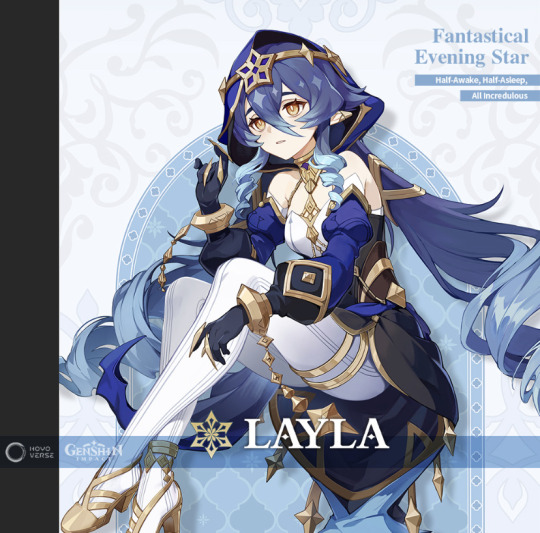
she’s the only other character who’s sitting down in their artwork aside from Kaeya, who, in theory, is sitting down because he’s sitting on his throne as a the heir to Khaenri’ah’s royal throne. Her hair and the tassels on her wrists as well as the back of her cape are the four-pointed stars we see on every Khaenri’ahn related character. Also her circlet, or crown (pointing to royalty) has some of the stars and the shading in her hair also is in the shape of the stars in a lighter, grayer color- like Kaeya’s streak of gray hair, or Pierro’s streak of navy hair. She shares a similar enough color palette to Dainsleif and Kaeya and Pierro and maybe even Albedo if you squint. What if she’s another member, or maybe even a sage, of Khaenri’ahn royalty- also sitting on a throne. Especially a royal sage or consultant of some sort, seeing as her pose looks like she’s advising someone to do something.
The four- pointed stars on Kaeya’s eye and clothes:
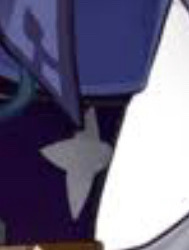
The four pointed stars on her:

The Official Genshin YouTube channel also posted this about her:

So she’s a sleepy character who apparently has never experienced sleepwalk, and by a stretch, has never had a dream. In the Genshin trailer: Travail, way back, the one where they show a small glimpse of the nations, Dainsleif mentions that “there are those who dream of dreaming.” He also mentions that “Some say a few are chosen and the rest are dregs.” Now I’m really stretching, but what if what happens to her here in this description is connected- what if the stars descending on her paper was her being ‘chosen’- she also calls it “The star’s blessing”. Especially with the fact that she had just woken up from a restful nap- what if she had a dream during that nap, and as a Khaenri’ahn, allowed her to be blessed by these random stars???
ALSO @genshin-impact-updates said that her constellation is apparently called ‘Luscinia’ so i googled it and (copy pasted from wikipedia) Luscinia is a genus of smallish passerine birds, containing the nightingales and relatives. It also said this:
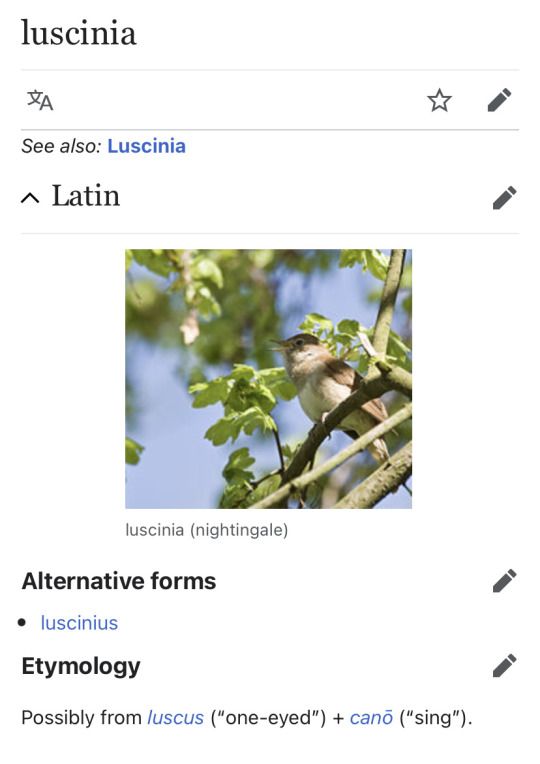
Now who else do we know is one eyed-?? Dain, Pierro, and Kaeya- all of them not only related to Khaenri’ah, but related to Khaenri’ahn royalty. I googled what nightingales symbolize, and apparently they symbolize a LOT like creativity and nature and melodies and mystery even???
I’ve also never seen a nightingale in my life but apparently they sing a lot at night so maybe she’s really supposed to symbolize some sort of magic or dreaming or stars or whatever as a Khaenri’ahn. At this point I’m really stretching but MY POINT IS BABE WAKE UP NEW KHAENRI’AH RELATED CHARACTER JUST DROPPED

Edit; I have something to add on the visual similarities between her and the other Khaenri’ahns we know. her hoodie/ veil is twisted to cover the right side of her face more than her left side. Just like Kaeya’s hair and eyepatch, as well as Pierro and Dain’s covered right sides. I think it’s a more subtle way of pointing to how Khaenri’ahns cover their eye just like their King Irmin mentioned in Hidden Strife.
Edit2: jk she can sleepwalk my bad Idk if she can dream or not tho
#genshin impact#genshin kaeya#kaeya alberich#dainsleif#albedo#layla genshin impact#khaenri'ah#genshin lore#genshin#genshin pierro#genshin impact lore#genshin theory#genshin impact theory
711 notes
·
View notes
Text
If Arlecchino killed everyone in the old House of the Hearth, and Freminet grew up there, shouldn’t he be dead? I don’t think he could’ve run away or escaped cuz Crucabena was the fourth Harbinger, she would’ve sent her soldiers after him. Did he get revived somehow? If so, why didn’t Clervie get revived instead?
#genshin#genshin impact#arlecchino#arlecchino genshin#freminet#freminet genshin#crucabena#peruere#clervie#house of the hearth#fatui harbingers#genshin theory#genshin impact theory#the song burning in the embers
30 notes
·
View notes
Text
Khaenri'an Blood Purity Through Eye Color?
This has spoilers for the 3.5 Archon Quest Cavibert. You've been warned!
Alright. I’m scatterbrained so I figured I’d talk about this. My main theory is that pureblooded Khaenri’an’s can be identified by teal eyes with Primogems.
We know all people with Khaenrian blood have primoshaped pupils but Kaeya specifically noticed that Dainsleif is stated to be “pure blood Khaenri’an”. The main difference between the two when it comes to eyes, the main thing connecting Khaenri’ans is their eye color (Kaeya having purplish eyes while Dain having teal)



Dainsleif and Chlothar are both stated to be “pure-blooded Khaenrian” and they both have the same bright teal eyes with primogem shaped pupils. This is also something Halfdan has from the Chasm quest so he might be a full blooded Khaenri’an too.

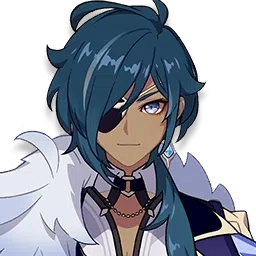
Kaeya on the other hand has a purplish blue eye. We know he has khaenri’an blood because he’s related to Chlothar and it’s stated in game through his voice lines and backstory. Plus, his primogem pupils are smaller and not as defined. It’s highly likely Kaeya is only part Khaenri’an, not full blooded. This has even been a theory for a while.

Finally, the last playable character who has a backstory related to Khaenri’ah who also has teal eyes, Albedo. While Albedo does not have the Primo-shaped eyes, his eyes match the Alchemy Crafting Table so that might be a side effect from his creation. Rhinedottir purposely made Albedo look as close to perfect originally with Subject Two/Susbedo but he was tossed. This might’ve been another symbol for “perfect” in Khaenri’ah, the teal eyes.
To add to this is the history behind blue eyes in the real world. Blue eyes are a genetic mutation from a single common ancestor and was bred throughout the years despite being a recessive gene. I think this might be something similar because Chlothar says during the quest he was a Khaenri’an noble and Khaenriah already is split between people who are “pure-blooded” vs people who aren’t (whose parents aren’t both from Khaenri’ah, like Caribert’s mother was from Mondstadt). The people who kept their bodies vs the people who turned into Hilichruls.
Khaenri’ah is shown in this quest, through Chlothar, that they had some elitism to other nations due to not worshiping the gods. The color of someone’s eyes might indicate to people how pure blooded the person is, if they are caring both the dominant trait (the primogem-shaped pupil) and the recessive trait (the teal eyes).
This might be why Kaeya was able to notice Dain was “pure-blood” so easily and why Rhinedottir gave Albedo teal eyes almost the same color as the purebloods. Just something to chew on :)
#genshin kaeya#kaeya alberich#kaeya genshin impact#genshin impact#genshin impact theory#caribert#caribert genshin#dainsleif#halfdan#khaenri'ah#genshin 3.5#genshin spoilers#genshin
234 notes
·
View notes